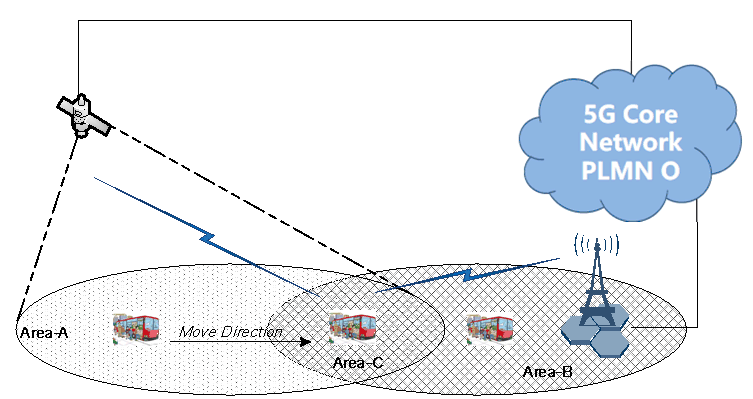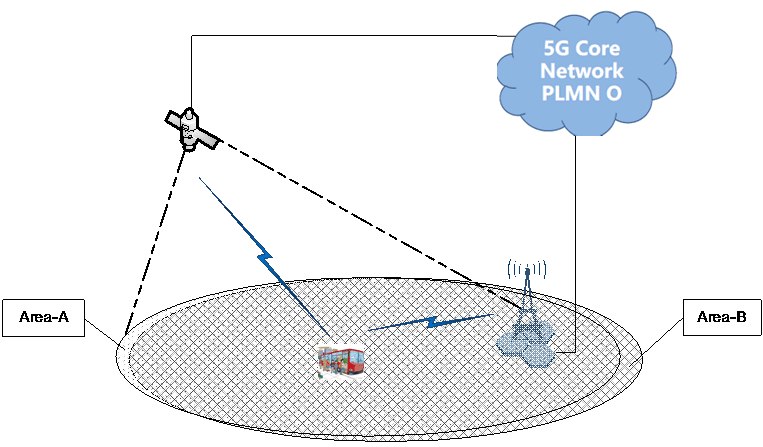Content for TR 22.839 Word version: 18.1.0
5.22 Mobility between Non-terrestrial coverage and terrestrial coverage for Mobile Vehicular Relays
5.23 Mobile Vehicular Relays using Non-terrestrial and terrestrial access simultaneously
5.22 Mobility between Non-terrestrial coverage and terrestrial coverage for Mobile Vehicular Relays p. 50
5.22.1 Description p. 50
In clause 5.16, use case for Non-terrestrial coverage for Mobile Vehicular Relays has been specified.
In acutal 5G deployment, some areas could be covered by both non-terrestrial coverage and terrestrial coverage, and some area areas are only covered by either the non-terrestrial coverage and terrestrial coverage.
It could be good to support mobility of mobile vehicular relays between non-terrestrial coverage and terrestrial coverage
5.22.2 Pre-conditions p. 50
The following are assumed to be available for this use case:
- 5G non-terrestrial access is provided in a area A by a non-terrestrial platform (e.g. a LEO, MEO satellite) of one PLMN named O;
- 5G terrestrial access is provided in a area B by a terrestrial (fixed) base station of same PLMN O;
- 5G non-terrestrial and terrestrial access is provided in an area C, with is the overlapped area of A and B, by a terrestrial access of one PLMN;
- One vehicle named V equipped with 5G mobile BS relays, is able to obtain access from a non-terrestrial platform and a terrestrial access of one PLMN;
- The vehicle relays provide 5G access to UEs inside the vehicle and UEs nearby the vehicle (e.g. those UEs could be normal smartphones, without satellite capabilities.)
5.22.3 Service Flows p. 50
The vehicle V equipped with 5G mobile BS relays locates within area A, and connect via non-terrestrial access to PLMN O, and provide the 5G access to UEs inside the vehicle.
The vehicle V drive within area A but heading to area B, then it moves into area C where both 5G non-terrestrial access and terrestrial access are available.
Since vehicle V equipped with 5G mobile BS relays detected there is both 5G non-terrestrial access and terrestrial access, and based on some criteria the 5G mobile BS relays decides to using terrestrial access to connect to 5GC. The criteria includes operator policy, signal strength of the access and etc.

Figure 5.22-1: Vehicle Relays move from a non-terrestrial access area to terrestrial access area
(⇒ copy of original 3GPP image)
(⇒ copy of original 3GPP image)
During the "relay switch", that is a period that 5G mobile BS relays switch from using the 5G non-terrestrial access to using the 5G terrestrial access to connect to 5GC, the 5G mobile BS relays continuing provide the 5G access to UEs inside the vehicle.
After this "relay switch", the vehicle V equipped 5G mobile BS relays drives in area B and provide the 5G access to UEs inside the vehicle.
5.22.4 Post-conditions p. 51
The vehicle V equipped with 5G mobile BS relays using 5G terrestrial access connect to 5GC, and provide the 5G access to UEs inside the vehicle.
5.22.5 Existing features partly or fully covering the use case functionality p. 51
Current stage-1 requirements (e.g. on wireless self-backhaul, in TS 22.261), as well as existing stage-2/3 functionalities and architecture options (e.g. IAB) do not assume or address full relay mobility (e.g. BS relays on board of moving vehicles), thus may not cover the identified new potential requirements, which are intended to be specific to mobile BS relays.
5.22.6 Potential New Requirements needed to support the use case p. 51
[PR 5.22.6-1]
The 5G System shall be able to support mobile base station relays using NR satellite access and using NR terrestrial access to connect to 5GC.
[PR 5.22.6-2]
The 5G System shall be able to support a mobile base station relay capable using both NR satellite access and NR terrestrial access with service continuity in the scenario when this mobile base station relay switch from using NR satellite access to using NR terrestrial access, and vice versa.
5.23 Mobile Vehicular Relays using Non-terrestrial and terrestrial access simultaneously p. 51
5.23.1 Description p. 51
In clause 5.16, use case for Non-terrestrial coverage for Mobile Vehicular Relays has been specified.
In actual 5G deployment, some areas could be covered by both non-terrestrial coverage and terrestrial coverage.
It could be good to support of mobile vehicular relays using non-terrestrial access and terrestrial access simultaneously to connect to 5GC.
5.23.2 Pre-conditions p. 51
The following are assumed to be available for this use case:
- 5G non-terrestrial access is provided in an area A by a non-terrestrial platform (e.g. a LEO, MEO satellite) of one PLMN named O;
- 5G terrestrial access is provided in an area B by a terrestrial (fixed) base station of same PLMN O;
- Area A and area B are largely overlapped;
- One vehicle named X equipped with 5G mobile BS relays, is able to using access from a non-terrestrial platform and a terrestrial access at same time;
- The vehicle relays provide 5G access to UEs inside the vehicle and UEs nearby the vehicle (e.g. those UEs could be normal smartphones, without satellite capabilities.)
5.23.3 Service Flows p. 51
The vehicle X equipped with 5G mobile BS relay locates within area A, it detects the access could be used to 5GC. Then it decides to connect via terrestrial access to PLMN O. Once successes, it then provide the 5G access to UEs inside the vehicle.
Due to some reasons, e.g. UE amounts accesses increase, huge demand of bandwidth, the vehicle X find that total bandwidth of current relay link could not meet above demands, and then vehicle X decides to use the non-terrestrial access as relay link.
The vehicle X then detect whether there is non-terrestrial access coverage. If yes, the vehicle X equipped with 5G mobile BS relay connect to the PLMN O. If it is authorised to provide 5G access to UEs, then more UEs and more bandwidths requirements could be meet. That is, more and more UE could access the network via this vehicle X equipped with 5G mobile BS.
The vehicle X equipped with 5G mobile BS monitors the usage of the relay link, and once the service demand decrease, it then decides to dis-connect one relay link, e.g. it dis-connect the terrestrial access link.
The vehicle X also monitors the radio coverage. For example, if there is no terrestrial access available, or the radio conditions of terrestrial access deteriorates, the vehicle X has no choice but to dis-connect the terrestrial access link

Figure 5.23-1: Vehicle Relays using non-terrestrial access and terrestrial access simultaneously
(⇒ copy of original 3GPP image)
(⇒ copy of original 3GPP image)
5.23.4 Post-conditions p. 52
The vehicle X equipped with 5G mobile BS relays using both 5G terrestrial access and non-terrestrial access connect to 5GC, and provide the 5G access to UEs inside the vehicle and UEs nearby the vehicle (e.g. those UEs could be normal smartphones, without satellite capabilities).
5.23.5 Existing features partly or fully covering the use case functionality p. 52
Current stage-1 requirements (e.g. on wireless self-backhaul, in TS 22.261), as well as existing stage-2/3 functionalities and architecture options (e.g. IAB) do not assume or address full relay mobility (e.g. BS relays on board of moving vehicles), thus may not cover the identified new potential requirements, which are intended to be specific to mobile BS relays.
5.23.6 Potential New Requirements needed to support the use case p. 52
[PR 5.23.6-1]
The 5G System shall be able to support mobile base station relays capable of connecting via both NR satellite access and NR terrestrial access, to select one access as a relay link between the mobile base station relays and the 5GC.
[PR 5.23.6-2]
The 5G System shall be able to support mobile base station relays capable of connecting simultaneously via NR satellite access and NR terrestrial access as relay link to connect via both to 5GC at the same time.
[PR 5.23.6-3]
The 5G System shall be able to support mobile base station relays capable of connecting in parallel via NR satellite and NR terrestrial access to add a second relay link to allow more UEs to access the network and e.g. to adapt to increased bandwidths demand for access via this mobile base station relay.
[PR 5.23.6-4]
The 5G System shall be able to support mobile base station relays connected via both NR satellite and NR terrestrial access to remove one of two relay links to adapt to decreased bandwidths demand of UEs accessing via this mobile base station relay.
[PR 5.23.6-5]
The 5G System shall be able to support mobile relay traffic load balancing across satellite and terrestrial access links, for mobile base station relays that use both NR satellite access and NR terrestrial access as relay link at the same time.